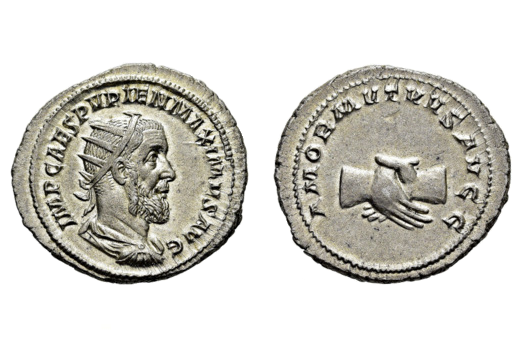
about ancient nomos
Ancient Nomos Art is a museum of galleries exhibiting ancient coins and ancient mint maps. The coin gallery displays the diverse art and history of hand-crafted ancient Greek, Roman, Byzantine, Persian and Medieval coinage. The ancient mints mapping gallery features Greek, Roman, Byzantine, Asia Minor and Medieval mint city regions and territories. Visitor's are welcome to explore, study and enjoy Ancient Nomos Art.

Imperial, Roman – 238 AD
Pupienus
From Ancient Galleries

Obverse: Radiate, paludamentum draped, and cuirassed bust of Emperor Pupienus facing right.
Reverse: AMOR MVTVVA AVGG legend, Pair of clasped right hands truncated at the wrists.
LEGEND
Obv: IMP CAES PVPIEN MAXIMVS AVG, Radiate, paludamentum draped, and cuirassed bust of Emperor Pupienus facing right. Rev: AMOR MVTVVA AVGG, clasped right hands.
Emperor Pupienus, known as Marcus Clodius Pupienus Maximus (c. 168 – 238) was Roman emperor with Balbinus for 99 days in 238 AD, during the year of the six emperors. The chief mint engraver in Rome during the brief six emperor in one year period is known for his masterful engravings, who produced some of the most realistic high quality and artful portraiture on coinage. The Pupienus denarius specimen above, and as seen on coins of the other so-called ‘ephemeral’ emperors including; Gordian I, Gordian II, Gordian III and Balbinus, none of whom reigned more than three months, points to the remarkable skill, gem-like artfulness and quick adaptability of the Roman mint during this tumultuous period. During the year 238 AD, die engravers created life-like effigies for no fewer than seven different Roman rulers (Maximinus I Thrax, Maximus II, the three Gordians, Balbinus and Pupienus) in very rapid succession, yet each engraved coin portrait is highly distinctive and realistic, confirmed by the evidence of surviving portrait busts, remarkably true to the unique individual physiognomy of each brief emperors reign. Although struck during the chaotic year of the six emperors, this silver antoninianus bears an outstanding fully mature portrait of the bearded, self-dignified and dignified 70 year old Pupienus. The reverse disingenuously shows his right hand clasped with that of his partner Balbinus, also chosen by the Roman Senate, along with the legend; AMOR MVTVVS AVGG, (Latin translation: Amor Mutuus Duorum Augustorum), celebrating “mutual affection of the two emperors (Augusti).” In reality the two emperors could not stand one another. Sources suggest that Balbinus suspected Pupienus of using his German bodyguard to overthrow him, and they were soon living in different parts of the Imperial palace. This meant that they were at the mercy of disaffected elements in the Praetorian Guard, who resented serving under Senate-appointed emperors, and now plotted to kill them. Pupienus, becoming aware of the threat, begged Balbinus to call for the German bodyguard. Balbinus, believing that this news was part of a plot by Pupienus to have him assassinated, refused, and the two began to argue just as the Praetorians burst into the room. Both emperors were seized and dragged back to the Praetorian barracks where they were tortured and hacked to death in the bath house. They only ruled as co-emperors for 99 days.
DOCUMENTATION
Value: Antoninianus. Metal: AR Silver. Weight: 4.81 grams. Mint: Rome, 2nd emission. Date: April-June 238 AD.
Attribution: Roman Imperial Coinage IV 9b; Cohen 2; BMCRE 82; Seaby & Sear, Roman Silver Coins, III; Leu 65, #447.
Legend, Documentation and Attribution
